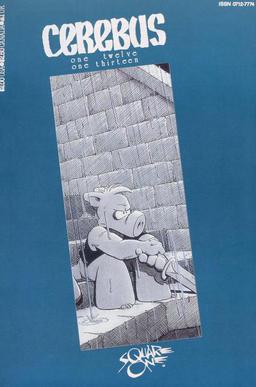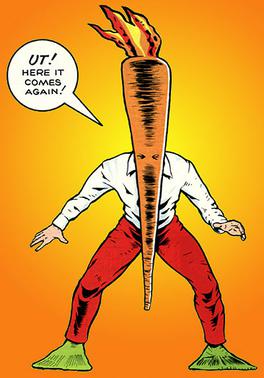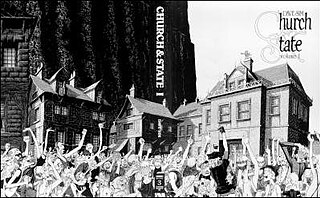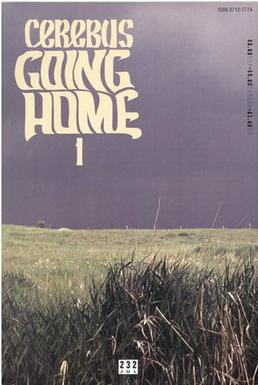
Cerebus is a comic book series, created by Canadian cartoonist Dave Sim, which ran from December 1977 until March 2004. The title character of the 300-issue series is an anthropomorphic aardvark who takes on a number of roles throughout the series—barbarian, prime minister, and pope among them. The series stands out for its experimentation in form and content, and for the dexterity of its artwork, especially after background artist Gerhard joined with the 65th issue. As the series progressed, it increasingly became a platform for Sim's controversial beliefs.

Gerhard is the professional name of a Canadian artist known for the elaborately detailed background illustrations in the comics series Cerebus the Aardvark.

Dave Sim is a Canadian cartoonist and publisher, known for his comic book Cerebus, his artistic experimentation, his advocacy of self-publishing and creators' rights, and his controversial political and philosophical beliefs.

Richard Veitch is an American comics artist and writer who has worked in mainstream, underground, and alternative comics.

Flaming Carrot Comics is an American superhero comic book created by Bob Burden, featuring the absurd, surreal adventures of the Flaming Carrot.
Aardvark-Vanaheim is a Canadian independent comic book publisher founded in 1977 by Dave Sim and Deni Loubert and is best known for publishing Sim's Cerebus.
The Creator's Bill of Rights is a document drafted in November 1988 by a number of independent comic book artists, writers, and publishers, designed to protect their rights as creators and publishers and oppose exploitation by corporate work for hire practices and the power of distributors to dictate the means of distribution. Issues covered by the Bill included giving creators proper credit for their characters and stories, profit-sharing, distribution, fair contracts, licensing, and return of original artwork. The signing of the Bill spurred Cerebus creator and self-publisher Dave Sim and Teenage Mutant Ninja Turtles creators/self-publishers Kevin Eastman and Peter Laird to sell or continue selling collected volumes of their comics directly to readers via their periodic issues, rather than through direct market distributors selling the collections at comic book specialty shops. Comic book professionals that have commented on the Bill conclude that it had little or no impact on the comic book industry.
glamourpuss is a Canadian independent comic book written and illustrated by Dave Sim which was published from April 2008 to July 2012 and ran for 26 issues. The comic was published bimonthly, with 24 pages of story and art, and back issues remaining available throughout the comic's print run. The premise of the book is threefold: a parody of fashion magazines, a history of photorealism in comics, and a surreal super-heroine comic.

High Society is the second collected volume, and first volume-length story, of Canadian cartoonist Dave Sim's Cerebus comic book series. It focuses mainly on politics, including Cerebus's campaign for the office of Prime Minister, in the fictional city-state of Iest in Sim's world of Estarcion. It is generally considered the best book for beginning Cerebus readers to start reading, and has been called "one of the finest storylines of the 1980s". The story was published in individual issues from May 1981 to May 1983 (#50), with the collection published in 1986.
Cerebus is the first collected volume of Canadian cartoonist Dave Sim's Cerebus comic book series. It is made up of the first 25 issues of Cerebus, plus, as of the 11th edition, some strips that ran in Comics Buyer's Guide featuring Silverspoon, a parody of the comic strip Prince Valiant.

Church & State is the third novel in Canadian cartoonist Dave Sim's Cerebus comic book series. In it, Cerebus once again becomes Prime Minister, and eventually Pope. The story was published in individual issues from July 1983 to June 1988 (#111).

Jaka's Story is the fourth major storyline in Canadian cartoonist Dave Sim's Cerebus comics series.

Melmoth is the fifth novel in Canadian cartoonist Dave Sim's Cerebus comic book series. It follows Oscar in his last days leading up until his death, while Cerebus sits catatonic, clutching the doll of Jaka, the woman he loves but believes has been killed.

Guys is the seventh novel in Canadian cartoon artist Dave Sim's Cerebus comic book series. It is made up of issues #201-219 of Cerebus and was collected as Guys in one volume in September 1997.

Rick's Story is the eighth novel in Canadian cartoonist Dave Sim's Cerebus comic book series. It is made up of issues #220-231 of Cerebus. It was collected as Rick's Story in one volume in November 1998, and was the 12th collected "phonebook" volume.

Going Home is the ninth novel in Canadian cartoonist Dave Sim's Cerebus comic book series. It is made up of issues #232–265 of Cerebus. It was collected as the 13th and 14th "phonebook" volumes, as Going Home and Form & Void.

Latter Days is the tenth and final novel in Canadian cartoonist Dave Sim's Cerebus comic book series. It is made up of issues #266-300 of Cerebus. It was collected as the 15th and 16th "phonebook" volumes, as Latter Days and The Last Day.
Mothers & Daughters may refer to:
Cerebus phonebooks are the paperback collections that Dave Sim has collected his comic book series Cerebus in since 1986. They have come to be known as "phonebooks" as their thickness and paper stock resemble that of phone books. The format had a large influence on alternative comics publishing and was key in the move from the periodical-centric publishing style that was once dominant.













